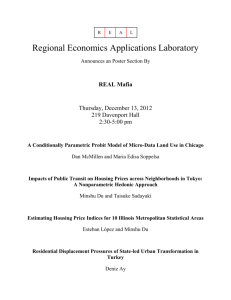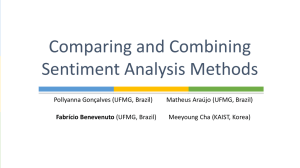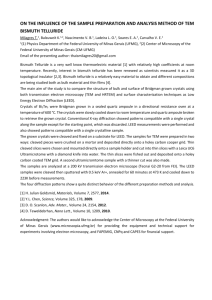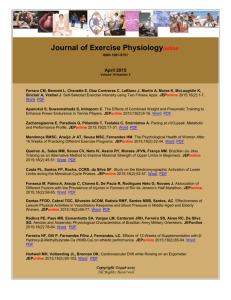8 - PPC10
advertisement
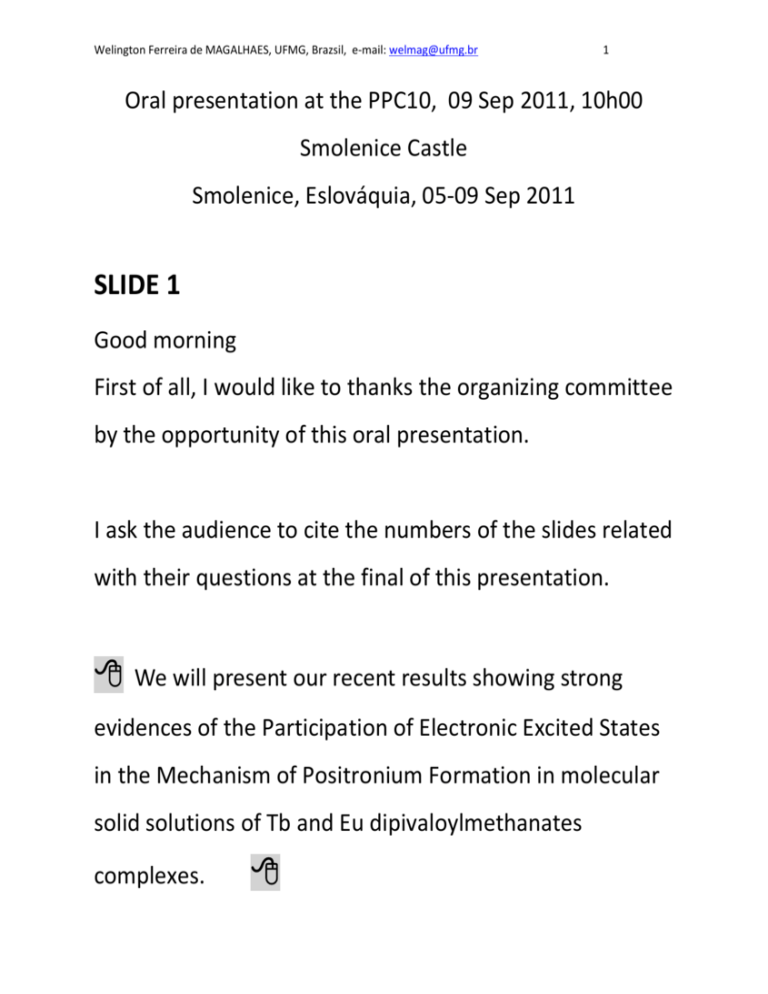
Welington Ferreira de MAGALHAES, UFMG, Brazsil, e-mail: welmag@ufmg.br
1
Oral presentation at the PPC10, 09 Sep 2011, 10h00
Smolenice Castle
Smolenice, Eslováquia, 05-09 Sep 2011
SLIDE 1
Good morning
First of all, I would like to thanks the organizing committee
by the opportunity of this oral presentation.
I ask the audience to cite the numbers of the slides related
with their questions at the final of this presentation.
We will present our recent results showing strong
evidences of the Participation of Electronic Excited States
in the Mechanism of Positronium Formation in molecular
solid solutions of Tb and Eu dipivaloylmethanates
complexes.
Welington Ferreira de MAGALHAES, UFMG, Brazsil, e-mail: welmag@ufmg.br
2
SLIDE 2
This work involves researches from four Brazilian
Universities.
I’m Welington MAGALHÃES from the laboratory of
Positron Annihilation Spectroscopies – LEAP, of the
Chemistry Department, of the Federal University of Minas
Gerais at Belo Horizonte, Brazil.
As shown by Dr. Mohalen on the brazil’s map, Belo
Horizonte e far from the beach.
So we dedicat our time on positron research.
Welington Ferreira de MAGALHAES, UFMG, Brazsil, e-mail: welmag@ufmg.br
3
SLIDE 3
In this work we used positron annihilation lifetime
spectroscopy, measured at room temperature, and
time resolved photoluminescence spectroscopy,
measured at room temperature and at liquid nitrogen
temperature,
to study the pure complexes of tb and Eu
dipivaloylmethanates and their binary molecular solid
solutions with different concentrations.
Welington Ferreira de MAGALHAES, UFMG, Brazsil, e-mail: welmag@ufmg.br
SLIDE 4
4
Oculto
The systems studied were the pure metallic complexes of dipivaloylmethanates
(dpm) of Tb and Eu and their substitutional solid solutions.
The studied complexes have molecular structures very similar to that of metallic
acetylacetonates complexes, changing the methyl groups by ter-buthyl
groups.
SLIDE 5
The Figure 2 shows the photoluminescence emission
spectra obtained at liquid nitrogen temperature, excited
at the wavelength 340 nm of the ligand excitation, for the
pure complexes and for three solid solutions of different
concentrations.
Note the two emissions of the Tb complex that do not
appears in the Eu complex, and
also the emission of the Eu complex inexistent in the
Tb complex.
Welington Ferreira de MAGALHAES, UFMG, Brazsil, e-mail: welmag@ufmg.br
5
SLIDE 6
The Figure 3 shows the luminescence excitation spectra
obtained at liquid nitrogen for the pure complexes, spectra
(a) and (b), and
for the solid solution of 0.5 mole
fraction, spectra (c) and (d), monitored at the wavelength of
emission of the Tb and of the Eu complexes, respectively.
Note the weak sharp band located around 485nm in the
spectrum (a) of the Tb complex, that doesn’t appears in the
spectrum (b) of the Eu complex, but appears in the both the
spectra (c) and (d) of the solid solution.
The emission at the Eu wavelength, in spectrum (d) of
the solid solution, when excited at the Tb wavelength,
indicates that an energy transfer process from Tb to Eu
occurs. This process is responsible by the observed
luminescence quenching, and by the positronium inhibition
in the solid solutions.
Welington Ferreira de MAGALHAES, UFMG, Brazsil, e-mail: welmag@ufmg.br
SLIDE 7
6
Oculto
Fig. 3 – Luminescence excitation spectra obtained at 77K temperature
for (a) Tb(dpm) , (b) Eu(dpm) ,
3
(c) Tb
(0.5)
(d) Tb
Eu
(dpm) (
(0.5)
Eu
(0.5)
3
3
emission
(dpm) (
(0.5)
3
emission
= 544 nm) and
= 615 nm).
Spectra (a) and c) were obtained under emission at 544 nm
5
7
corresponding to the Tb( D F ) transition.
4
5
Excitation spectra b) and d) were recorded with emission monitored at
5
7
615 nm corresponding to the Eu( D F ) transition.
0
SLIDE 8
2
Oculto
Broad band observed from approximately 250 to 420 nm corresponds
1
1 *
to the absorption in the dpm ligand.
3 * 5
The energy transfer process D4 then takes places.
The behaviour of the weak sharp band located around 485nm in the
excitation spectra (b),
(c) and (d) indicates the occurrence of a
Tb(III) Eu(III) energy transfer process.
Welington Ferreira de MAGALHAES, UFMG, Brazsil, e-mail: welmag@ufmg.br
7
SLIDE 9
To summaries these photoluminescence results, the
Figure 4 shows the partial energy level diagram for the
relevant photophysical processes associated with the
photoluminescence in the pure complexes and in their
solid solutions.
Note the Tb toward Eu energy transfer.
Welington Ferreira de MAGALHAES, UFMG, Brazsil, e-mail: welmag@ufmg.br
8
SLIDE 10
The Table 1 presents the PALS parameters and the
photoluminescence lifetimes of the studied systems,
where we can note the increasing Ps inhibition and
the increasing quenching of the luminescent lifetime,
promoted by the increasing Eu complex mole fraction.
We can also note that the Eu complex almost doesn’t form Ps.
Welington Ferreira de MAGALHAES, UFMG, Brazsil, e-mail: welmag@ufmg.br
9
SLIDE 11
The Figure 5 shows the linear quenching of the lifetime of
5
the luminescent D4 excited state level of the Tb central
ion in the Tb complex versus the mole fraction of the Eu
complex in the solid solutions.
The experimental data are at room and liquid nitrogen
temperatures.
The slopes of the linear fits determine the
luminescence quenching rate constants.
Welington Ferreira de MAGALHAES, UFMG, Brazsil, e-mail: welmag@ufmg.br
10
SLIDE 12
The Figure 6 shows the Inhibition of the o-Ps intensity as a
function of the mole fraction of Eu complex.
This typical Stern-Volmer behavior was fitted with the
equation (19), obtained from the proposed kinetic
mechanism, using the parameters presented in the lines
(a), (c) and (d) of the Table 2.
Welington Ferreira de MAGALHAES, UFMG, Brazsil, e-mail: welmag@ufmg.br
11
SLIDE 13
The Figure 7 shows a strong linear correlation between
the ortho-positroniun intensity and the luminescence
lifetime of the Tb 5D4 excited state.
The squares represent the experimental data
presented in the Table 1.
The circles represent the calculated ortho-positronium
intensity obtained from the equations of the proposed
kinetic model, using the fitted parameters presented in
the line (a) of the Table 2.
Welington Ferreira de MAGALHAES, UFMG, Brazsil, e-mail: welmag@ufmg.br
12
SLIDE 14
The Figure 8 presents the scheme of the proposed kinetic
mechanism, showing the Ps formation from the ligand
excited state of the metallic complexes, and
the luminescence quenching, due to the energy
transfer from Tb toward Eu ions with rate constant k8Tb.
This process is responsible by the Ps formation inhibition
and takes place only in the solid solutions.
We call the cybotatic systems, formed by the positron
with the ligand excited state or whit the metal central ions
excited states in the complexes, as the “direct and indirect
Ps formation precursors”, respectively.
Welington Ferreira de MAGALHAES, UFMG, Brazsil, e-mail: welmag@ufmg.br
SLIDE 15
13
Oculto
The kinetic reaction equations for the Tb complex branch of the
mechanism are shown in this slide and in the next two slides.
The reaction (3Tb) is responsible for the Ps formation and compete
with other reactions.
SLIDE 16
Oculto
The reaction (7Tb) is responsible by the luminescent light emission
and, indirectly also compete with the Ps formation.
The reaction (8Tb) is responsible by the quenching of the
luminescent Tb(III) excited state and, indirectly also compete with the
Ps formation, promoting the Ps inhibition by the Eu complex solute in
the solid solutions.
SLIDE 17 Oculto
The reaction (9Tb) is the ligand to metal charge transfert – LMCT
and, if occur, also compete indirectly with the Ps formation.
Welington Ferreira de MAGALHAES, UFMG, Brazsil, e-mail: welmag@ufmg.br
14
SLIDE 18
The equations (12) and (13) are the kinetic equations of
appearance and disappearance of both the direct and
indirect Ps formation precursors of the Tb reactions chain.
The equation (16) shows that the decay constant of the
luminescent Tb excited state increases linearly with the
increasing Eu complex concentration, quenching its lifetime,
as shown in Figure 5.
The luminescence quenching rate constant has two
contributions.
Welington Ferreira de MAGALHAES, UFMG, Brazsil, e-mail: welmag@ufmg.br
15
SLIDE 19
Applying the steady-state hypothesis in the equations (12)
and (13) the equation (18) is obtained.
The first and the second parcels in the numerator of
this equation show that there are two contributions for
the probability of Ps formation: the first from the Tb
complex and the second from the Eu complex.
Simplifying this equation assuming that the second parcel
into the parenthesis in the numerator is very low
compared with the first one; this is equivalent to
neglecting the fraction of Ps formed from the Eu reaction
chain; the equation (19) is obtained.
Welington Ferreira de MAGALHAES, UFMG, Brazsil, e-mail: welmag@ufmg.br
SLIDE 20
16
Oculto
The probability of Ps formation, I3, should be proportional to the
probability of presence of the direct Ps formation precursor, with its
ligand 3* triplet excited state:
The proportionality constant k is dependent on k3Tb, the reaction rate
constant for the reaction (3Tb) of Ps formation. For simplicity we
assume k = 1.
SLIDE 21
Oculto
The equation (18)
can already explain our results, but it has many
fitting parameters, and is coupled with the equations of the Eu reaction
chain in the model presented in Fig. 8 . The model complete
solution is very complicated.
retornar.
To simplify the equation (18) it is assumed that the second parcel into
the parenthesis in the numerator is very low compared with the first
one. This is equivalent to neglecting the fraction of Ps formed in the Eu
reaction chain, leading to the equation (19).
Welington Ferreira de MAGALHAES, UFMG, Brazsil, e-mail: welmag@ufmg.br
17
SLIDE 22
This equation has now 7 fitting parameters, much less
than the previous equation (18).
SLIDE 23
The Table 2 shows the values of the fitted parameters of
equation (19) on the positronium yields shown in Table 1.
The fits (a), (c) and (d) were shown in Figure 6.
The parameters without uncertainties are fixed values.
Welington Ferreira de MAGALHAES, UFMG, Brazsil, e-mail: welmag@ufmg.br
18
SLIDE 24
CONCLUSIONS
From the proposed mechanism a equation was deduced, and it
describes very well the inhibition of Ps formation performed by the Eu
complex, as well as the linear correlation between the Ps formation
probability and the lifetime of the Tb 5D4 luminescent excited state of
the Tb complex, the indirect Ps formation precursor.
SLIDE 25
The proposed mechanism raises strong evidences of the participation
of electronic excited states as precursors for the Ps formation, at the
positron molecule scattering, what is a characteristic of the Ore and
resonant models.
As in the spur model the proposed mechanism presents various
competitive reactions that can reduce the probability of positronium
formation, in a way completely consistent with the stern-Volmer
behavior.
Welington Ferreira de MAGALHAES, UFMG, Brazsil, e-mail: welmag@ufmg.br
SLIDE 26 – 32
Oculto
Some REFERENCES related with this work are presented in the following slides
SLIDE 33
Thanks for your attention
Some questions?
19
Welington Ferreira de MAGALHAES, UFMG, Brazsil, e-mail: welmag@ufmg.br
20
@@@@@@@@@@@@@@@@@@@@@@@@
SLIDE 1
Good morning
First of all I would like to thanks the organizing committee by the
opportunity of this oral presentation.
I ask the audience to cite the numbers of the slides related with their
questions at the final of this presentation.
We will present our recent results showing strong evidences of the
Participation of Electronic Excited States in the Mechanism of
Positronium Formation in Tb1-xEux(dpm)3 solid solutions
Welington Ferreira de MAGALHAES, UFMG, Brazsil, e-mail: welmag@ufmg.br
21
SLIDE 2
This work involves researches from four Brazilian Universities.
I’m Welington MAGALHÃES from the laboratory of Positron
Annihilation Spectroscopies.
In Portuguese: Laboratório de Espectroscopia de Aniquilação de
pósitrons – LEAP, of the chemistry Department, of the Federal
University of Minas Gerais –UFMG at Belo Horizonte, Brazil.
SLIDE 3
In this work we used positron annihilation lifetime spectroscopy
measured at room temperature and time resolve photoluminescence,
measured at room temperature and at liquid nitrogen temperature.
Welington Ferreira de MAGALHAES, UFMG, Brazsil, e-mail: welmag@ufmg.br
22
SLIDE 4
The systems studied were the pure metallic complexes of
dipivaloylmethanates (dpm) of Tb and Eu and their substitutional solid
solutions.
The studied complexes have molecular structures very similar to that of
metallic acetylacetonates complexes,
changing the methyl groups
by ter-buthyl groups.
SLIDE 5
The Figure 2 – Photoluminescence emission spectra obtained at liquid
nitrogen temperature, excited at 340 nm for the pure complexes and
three solid solutions of different concentrations.
5
7
Emission at 484-489 nm correspond to the Tb( D4 F6) transition.
5
7
Emission at 544 nm correspond to the Tb( D4 F5) transition.
5
7
Emission at 615 nm corresponding to the Eu( D0 F2) transition
Welington Ferreira de MAGALHAES, UFMG, Brazsil, e-mail: welmag@ufmg.br
23
SLIDE 6
The Figure 3 shows the luminescence excitation spectra (a) and (b)
obtained at 77K for the pure complexes and (c) and (d) are the spectra
for the solution of 0.5 mole fraction monitored at 544 nm and 615 nm,
respectively
Note the weak sharp band located around 485nm that doesn’t
appears in the spectrum (b) of the Eu complex but appears in the both
the spectra (c) and (d) of the solid solution.
Spectra a) and c) were obtained under emission at 544 nm
5
7
corresponding to the Tb( D F ) transition 5 .
4
5
Excitation spectra b) and d) were recorded with emission
5
7
monitored at 615 nm corresponding to the Eu( D F ) transition 5 .
0
2
The broad band observed from approximately 250 to 420 nm in the
excitation spectrum
6
enveloped with narrow absorption peaks
Welington Ferreira de MAGALHAES, UFMG, Brazsil, e-mail: welmag@ufmg.br
24
of the Tb(5D47F5) transition in Tb(dpm)3 complex, shown in
Figure 3(a), corresponds to the 11* absorption in the dpm ligand.
The behavior of the weak sharp band located around 485nm
6 in
the excitation spectra (b), (c) and (d) indicates the occurrence of a
Tb(III) Eu(III) energy transfer process. This process is responsible by
the luminescence quenching, and, as wil be demonstrate later, by the
positronium inhibition in the solid solutions.
SLIDE 7
Oculto
SLIDE 8
Oculto
Welington Ferreira de MAGALHAES, UFMG, Brazsil, e-mail: welmag@ufmg.br
25
SLIDE 9
To summaries the photoluminescence results, the Figure 4 shows the
partial energy level diagram for the relevant photophysical process
associated with photoluminescence in Tb Eu (dpm) solid solutions.
1-x
x
3
The electronic transitions are represented by dashed arrows and the
corresponding transition reaction rate constants are over wrote.
Note Tb toward Eu energy transfer with rate constant k8Tb.
SLIDE 10
Table 1 – Presents the PALS parameters (lifetimes and intensities) at
(294 1) K, 1 fixed at 0.120 ns, and the luminescence lifetimes for
Tb1‑xEux(dpm)3 solid solutions.
It’s clear the increasing Ps inhibition, with decreasing I3, and the
increasing quenching of the luminescent lifetime, with its {LTb*e+}
lifetime reduction, promoted by the increasing Eu complex mole
fraction.
Welington Ferreira de MAGALHAES, UFMG, Brazsil, e-mail: welmag@ufmg.br
26
SLIDE 11
The Figure 5 – shows the luminescence decay constants (reciprocal of
5
the lifetime) for the luminescent D4 excited state level of Tb(III) ion in
the Tb(dpm)3 complex versus the mole fraction of Eu(dpm)3 complex in
the Tb1-xEux(dpm)3 solid solutions.
Continuous lines with open squares refer to data at 298 K.
Dashed lines with open circles refer to data at 77 K.
Both the fits of the four data points or the first three data points are
shown.
SLIDE 12
The Figure 6 shows the Inhibition of the o-Ps intensity as a function of
the mole fraction of Eu(III) complex.
The lines shows the fit (a) of medium quality, the worst fit (b) and
the best fit (d) of the equation (19)
obtained from the proposed
kinetic mechanism and presented in Table 2
.
Welington Ferreira de MAGALHAES, UFMG, Brazsil, e-mail: welmag@ufmg.br
27
SLIDE 13
The Figure 7 shows the strong linear correlation between the ortho5
positroniun intensity I3 and the luminescence lifetime of the Tb(III) D4
energy level.
The squares represents the experimental data of the Table 1.
2
These data were fitted by the continuous line with R = 0.9749.
The circles represents the calculated I3calc values of 39.4, 23.2,
14.0 and 13.2%, obtained from the equation (16) inserted into the
equation (19) and using the fitted parameters (a) presented in Table 2.
Due to the smoothing effect of the equations (16) and (19) fitting, the
dashed line fitted to the calculated I3 values are even more correlated
2
with the luminescence lifetimes, R = 0.9796, .
Welington Ferreira de MAGALHAES, UFMG, Brazsil, e-mail: welmag@ufmg.br
28
SLIDE 14
The Figure 8 shows the scheme for the kinetic mechanism of the Ps
formation from ligand excited states in Tb1-xEux(dpm)3 solid solutions,
showing the Ps inhibition formation and the luminescence quenching,
due to energy transfer between Tb(III) and Eu(III) ions.
We call the cybotatic system represented by the ligand triplet
excited state and a epithermal positron as the “direct Ps formation
precursor”
and the cybotatic system represented by the Eu complex central ion
excited state and an epithermal positron as the “indirect Ps formation
precursor”
The process with rate constant k8Tb is the energy transfer from
Tb toward Eu complex
Welington Ferreira de MAGALHAES, UFMG, Brazsil, e-mail: welmag@ufmg.br
29
SLIDE 15
The kinetic reaction equations for the Tb complex branch of the
mechanism are shown in this slide and in the next two slides.
The reaction (3Tb) is responsible for the Ps formation and compete
with other reactions.
SLIDE 16
The reaction (7Tb) is responsible by the luminescent light emission
and, indirectly also compete with the Ps formation.
The reaction (8Tb) is responsible by the quenching of the
luminescent Tb(III) excited state and, indirectly also compete with the
Ps formation, promoting the Ps inhibition by the Eu complex solute in
the solid solutions.
Welington Ferreira de MAGALHAES, UFMG, Brazsil, e-mail: welmag@ufmg.br
30
SLIDE 17
The reaction (9Tb) is the ligand to metal charge transfert – LMCT
and, if occur, also compete indirectly with the Ps formation.
SLIDE 18
The equations (12) and (13) are the kinetic equations of
appearance and disappearance of both the direct and indirect Ps
formation precursors.
The equation (16) shows that the decay constant of the
luminescent Tb(III) excited state increases linearly with the increasing
Eu complex concentration, quenching the lifetime of this excited state.
The quenching constant of luminescence has the contribution of
two reaction rate constants.
Welington Ferreira de MAGALHAES, UFMG, Brazsil, e-mail: welmag@ufmg.br
31
SLIDE 19
Applying the steady-state hypothesis on equations (12) and (13) leads
to the equation (18).
The first and the second parcels in the numerator of this equation
shows that there are two contributions for the probability of Ps
formation: the first form the Tb complex and the second from the Eu
complexe.
k’1Tb is a pseudo first order reaction rate constant for the ligand
excitation by epithermal positrons. Since the probability of epithermal
positrons presence is dependent of the positron source activity, which
can be considered constant during the spectrum measurement, k’1Tb
is a constant value.
Welington Ferreira de MAGALHAES, UFMG, Brazsil, e-mail: welmag@ufmg.br
32
SLIDE 20
The probability of Ps formation, I3, should be proportional to the
probability of presence of the direct Ps formation precursor, with its
ligand 3* triplet excited state:
The proportionality constant k is dependent on k3Tb, the reaction rate
constant for the reaction (3Tb) of Ps formation. For simplicity we
assume k = 1.
SLIDE 21
The equation (18)
can already explain our results, but it has many
fitting parameters, and is coupled with the equations of the Eu reaction
chain in the model presented in Fig. 8 . The model complete
solution is very complicated.
retornar.
To simplify the equation (18) it is assumed that the second parcel into
the parenthesis in the numerator is very low compared with the first
one. This is equivalent to neglecting the fraction of Ps formed in the Eu
reaction chain, leading to the equation (19).
Welington Ferreira de MAGALHAES, UFMG, Brazsil, e-mail: welmag@ufmg.br
33
SLIDE 22
This equation (19) has now 7 fitting parameters, less than the
previous equqtion (18).
SLIDE 23
The Table 2: shows the values of the fitted parameters of
equation (19) on the positronium yields I3 in Table 1. Three of these
fits are shown in Fig. 6.
The parameters without uncertainties are fixed values.
The uncertainties were obtained by a numerical procedure, studying
the curvature of the residual sum of squares around their minimum
value.
Welington Ferreira de MAGALHAES, UFMG, Brazsil, e-mail: welmag@ufmg.br
34
The columns 2 and 3 shows the decay constant and the
corresponding lifetime of the direct Ps precursor the triplet pi ligand
excited state.
The columns 4 and 5 shows the decay constant and the
corresponding lifetime of the indirect Ps precursor the Tb(III) central
ion excited state of the Tb(dpm)3 complex.
These values were fixed to the value obtained from the time resolved
photoluminesce spectrum for pure Tb(dpm)3 complex as shown in
Table 1
.
The column 6 shows the pseudo-first order rate constant for the
reaction (1Tb)
of production of the direct Ps formation
precursor.
The column 7 shows the rate constant for the reaction (4Tb) of
energy transfer from the direct Ps formation precursor towards the
indirect one
.
Welington Ferreira de MAGALHAES, UFMG, Brazsil, e-mail: welmag@ufmg.br
35
The column 8 shows the rate constant for the reaction (5Tb) of
energy transfer backward from the indirect Ps formation precursor
towards the direct one
.
The column 9 shows the rate constant for the reaction (6Tb) of
ligant to metal charge transfert
, leading to non-luminescent
metal excited. If occur, this reaction can efficiently reduce the
probability of Ps formation, and is probably the reason for what the
Eu(dpm)3 complex almost not form Ps.
The column 10 shows the luminescence quenching rate constant
kQlum = k8Tb + k9Tb the sum of the rate constants for the reaction (8Tb)
and (9Tb) that promotes the disappearance of the indirect Ps formation
precursor through its interaction by energy transfer towards the
Eu(dpm)3 complex
.
Finally the column 11 and last one shows standard deviation of the
fit, a measurement of the goodness of the fit. All the fits have standard
deviations in reasonable agreement with the experimental uncertainty
of the I3 values depicted in Table 1
and measured by PALS.
Welington Ferreira de MAGALHAES, UFMG, Brazsil, e-mail: welmag@ufmg.br
SLIDE 24 - 27
CONCLUSIONS
SLIDE 27
CONCLUSIONS
SLIDE 28 - 34
Oculto
Some REFERENCES related with this work are presented in the
followins slides
SLIDE 35
Thanks for your attention
Some questions?
36
